Some ideas revolutionize art. We change the way we see the world and what art is supposed to show us. Is it the divine, or the human? Is it the effect society has on individuals or vice versa? Is it a blob that is open to interpretation?
Some of the art movements of the centuries past have stuck around and can be seen today. Here are 5 of the most influential ones that you can still see around. Enjoy.
Minimalism

Why bother with too many details? What you see is what you get, less is more, and other sayings. It takes a really creative mind to convey an idea or feeling with as little as possible. There is something eye-catching as the minimal shapes, colors, and silhouettes are all there is to it. It was the movement of the 60s and early 70s and features repetition and gradual variation and the whole movement was present everywhere – car design, architecture, novels – you name it.
Today, Minimalism is used heavily in logo design, among other things.
Impressionism
When you want to break away from Realism and try to come up with your own style of painting that relies on how it makes an impression, this is what you get. It was once hated as barbaric since the pioneers of the movement slapped the academic art in the face by not using realistic brush strokes in their paintings. They even dared to paint outside, the nerve! Impressionism taught us that it is okay to break away from tradition and to experiment with the moment. And Post-Impressionism broke away completely from the reality of color and light and how they are perceived. That’s why we love Van Gogh.
Cubism

Pablo Picasso and Georges Braque created one of the best-known movements of the modernist era – Cubism. The movement got its name from an art critic in 1908 commenting on Braque’s House at L’Estaque by saying that it looks like cubes. In other words, the movement that came to be used in sculptures, music, and literature as well, focused on using cubes, spheres, cylinders, and cones.
It’s not so much that you can still see it today, as it is responsible for many different art movements, like Futurism, Purism, Dadaism, and so on. Like Surrealism and a few other movements, it became a political statement. However, we are looking at the proud parent with many children still up and about.
Vorticism
You likely have some old books that used Vorticism for their cover art, especially if they came from England. This movement was a bit geographically focused, but it has found its way to the rest of the world as well. The geometric shapes and straight lines are partially a product of Cubism and the idea behind the movement was to break away from the Victorian past and move on to the machine-oriented future. It focused on the brighter tomorrow and the breaking away from social positions.
Surrealism

I’ll admit that I love Dali’s paintings without understanding them.
Surrealism brings together different realities or, rather, different objects that have no reason to be together in a setting that seems to follow dream-logic. The works are about the surprise and connecting elements as an unconscious mind would.
Personally, I’ve enjoyed a few books that used Surrealism as a tool to create humorous situations. It is the shock, the non sequitur that intrigues people and makes them think. It is one of the perfect tools for challenging conventional thinking and creating new concepts.
